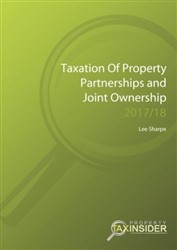
 Tax Saving Through Joint Ownership – Summary Of Benefits
Tax Saving Through Joint Ownership – Summary Of Benefits
The precise saving potentially to be made will depend on the particular circumstances, with due regard to adjustments for pension contributions, gift aid, and particular types of income and gains, but as a general rule, for 2017/18:
- Where a 40% taxpayer is able to share his or her income with another who has unused 20% Basic Rate band, then the overall tax saving can be as high as £6,700 for each additional joint owner (Basic Rate Band of £33,500 @ (40% - 20%)).
- Where a 40% taxpayer is able to share his or her income with another who has no other income at all, such that all of their tax-free Personal Allowance is also available, then the tax saving can be as high as £11,300 per additional joint owner.
Other factors potentially to consider where prospective joint owners are close family, etc:
Benefits entitlement – a person may lose entitlement to state benefits if his or her income increases (although several income benefits are assessed by reference to overall household income anyway, so the first investor’s income may already be ‘counted’);
Student Loan Repayments – a liability is triggered once income exceeds a certain threshold (£17,775 for ‘Plan 1’ loans in 2017/18; £21,000 for ‘Plan 2’ loans) so receipt of additional income can trigger a loan repayment, while a fall in assessable income may reduce exposure;
Capital Gains Tax – access to the lower rate(s) of CGT of 10% (18% where disposing of an interest in residential property) depends on the extent to which the taxpayer has unused Income Tax Basic Rate Band (TCGA 1992 s 4 et seq.);
Transferrable Marriage Allowance – the flexibility to transfer ‘unused’ Personal Allowance to one’s spouse or civil partner may be forfeit if either the ‘donor’ or ‘donee’s’ income is too high. But, in most circumstances, it will be at least as efficient for each taxpayer to keep and utilise their own Personal Allowance in full (ITA 20017 s 55B, 55C);
Access to the full £1,000 New ‘Savings Allowance’ – the effective 0% rate band attaching to any savings income above the Starting Rate for Savings falls from £1,000 to £500 when the taxpayer has ‘higher rate income’ (ITA 2007 s 12A, 12B);
High Income Child Benefit Charge/Clawback – where ‘Adjusted Net Income’ (ANI) exceeds £50,000 then any Child Benefit must be repaid at a rate of 0.01% for every £1 ANI exceeds £50,000, such that once ANI reaches £60,000, all Child Benefit must be repaid. The liability falls on whoever is the higher earner in a couple looking after eligible children, so where both taxpayers are exposed, balancing ANI between the two taxpayers may retain the most Child Benefit and therefore prove most efficient (ITEPA 2003 s681B – H);
Loss of tax-free Personal Allowance – as mentioned in the above example, the Personal Allowance is tapered away at a rate of £1 for every £2 of ‘Adjusted Net Income’ in excess of £100,000 (ITA 2007 s 35);
Access to ‘Tax-Free’ Childcare – also, where either parent in a family has ‘Adjusted Net Income’ in excess of £100,000, the new regime of childcare tax ‘breaks’ will not be available;
Proximity to Additional Rate Threshold – where income is taxed at 45% (ITA 2007 s 10);
Access to the reduced £500 New ‘Savings Allowance’ – reduced to nil where the taxpayer has ‘additional-rate income’ (ITA 2007 s 12A, 12B); and
Restriction of the Pension Annual Allowance – tax relief for pension contributions is restricted by clawback where contributions exceed the taxpayer’s Annual Allowance; the standard Annual Allowance is £40,000 but is tapered at a rate of 50% where ‘adjusted income’ exceeds £150,000. Note that ‘adjusted income’ includes rental income and does not comprise only the ‘relevant earnings’ that are required in order to make pension contributions in the first place (FA 2004 s 228ZA).
Access to losses, CGT Annual Exemptions, and exposure to the 3% SDLT surcharge for additional residential properties may also be relevant for joint owners.
Finance Cost Restriction for Joint Residential Investors (including Partnerships)
The impact of the restriction of interest and affiliated costs for those letting residential property will also affect the business model, but merits special consideration. The new regime does not ‘care’ whether the property is let in sole names, joint names, or as a ‘full’ partnership since it applies to all entities that are subject to Income Tax. (ITA 2007 s 272A et seq.)
The basic mechanism for individuals is that their (respective share of) finance costs is disallowed, but they will get a corresponding 20% Basic Rate tax ‘credit’ to offset against their eventual tax bill. In theory, this means that only 40% Higher Rate taxpayers and above will be affected, but those BTL investors who are currently ‘only’ 20% Basic Rate taxpayers should not assume that they will not be affected by the new regime: many such taxpayers will end up as 40% Higher Rate taxpayers because of the way that the system works.
 This is a sample extract from the report ‘Taxation Of Property Partnerships and Joint Ownership’ published by TaxInsider.co.uk.
This is a sample extract from the report ‘Taxation Of Property Partnerships and Joint Ownership’ published by TaxInsider.co.uk.


Please register or log in to add comments.
Thanks for sharing this best stuff with us! Keep sharing! I am new in the blog writing.All types blogs and posts are not helpful for the readers.Here the author is giving good thoughts and suggestions to each and every readers through this article.Visit http://buyessays.co/